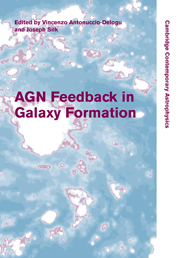Book contents
- Frontmatter
- Contents
- List of contributors
- Preface
- The organising committees
- Part I AGNs, starbursts and galaxy evolution
- Part II Co-evolution of black holes and galaxies
- Part III Outflows and radio galaxies
- Part IV Models and numerical simulations: methods and results
- 12 Physical models of AGN feedback
- 13 Large-scale expansion of AGN outflows in a cosmological volume
- 14 Relativistic jets and the inhomogeneous interstellar medium
- 15 AGN feedback effect on intracluster medium properties from galaxy cluster hydrodynamical simulations
- 16 Physics and fate of jet-related emission line regions
- 17 Cusp–core dichotomy of elliptical galaxies: the role of thermal evaporation
- Index
12 - Physical models of AGN feedback
from Part IV - Models and numerical simulations: methods and results
Published online by Cambridge University Press: 10 November 2010
- Frontmatter
- Contents
- List of contributors
- Preface
- The organising committees
- Part I AGNs, starbursts and galaxy evolution
- Part II Co-evolution of black holes and galaxies
- Part III Outflows and radio galaxies
- Part IV Models and numerical simulations: methods and results
- 12 Physical models of AGN feedback
- 13 Large-scale expansion of AGN outflows in a cosmological volume
- 14 Relativistic jets and the inhomogeneous interstellar medium
- 15 AGN feedback effect on intracluster medium properties from galaxy cluster hydrodynamical simulations
- 16 Physics and fate of jet-related emission line regions
- 17 Cusp–core dichotomy of elliptical galaxies: the role of thermal evaporation
- Index
Summary
Introduction
The idea that AGN activity can detectably influence the evolution of stellar populations in galaxies was advanced about 10 years ago (Silk and Rees 1998). This feedback can either manifest itself in the form of episodes of induced star formation, as originally suggested by Silk and Rees, or one could also imagine that the impressive release of energy from the AGN's jet to the interstellar medium (ISM) of its host galaxy could inhibit stellar formation. The first form is called positive feedback, while the second is often termed negative feedback. Both forms of feedback have durations of the order of a few times 107 years, i.e. the timescale of the AGN's duty cycle. This is a very short timescale in terms of galaxy evolution: thus the detection of negative feedback becomes possible by inspecting the statistical properties of colour–colour and colour–magnitude diagrams in some bands that are sensitive to recent star formation episodes. Only recently, with the massive exploitation of data from large-scale surveys such as the Sloan Digital Sky Survey, has it become possible to obtain galaxy samples large enough to check these effects (see for instance the contribution by Silverman et al. in this volume, Chapter 4).
Only more recently, however, have simulations of the jet–ISM interaction been attempted (see for instance the contributions by Bicknell et al. and Krause and Gaibler in this volume, Chapters 14 and 16).
- Type
- Chapter
- Information
- AGN Feedback in Galaxy Formation , pp. 111 - 156Publisher: Cambridge University PressPrint publication year: 2010

